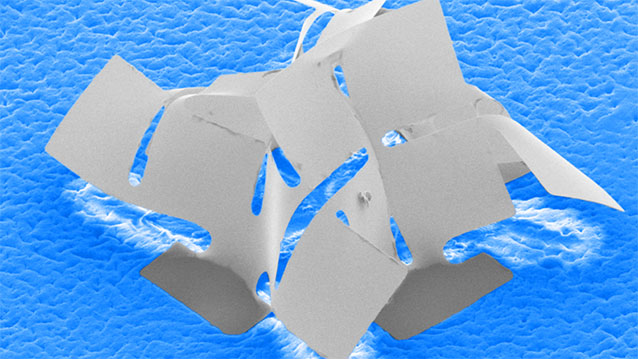Researchers from the Northwestern University, Tsinghua University and the University of Illinois have developed a method that uses cuts in a material to assemble complex 3D nano- and microstructures from materials like silicon.
 A new assembly method based on an ancient Japanese paper art quickly transforms 2-D structures into complex 3-D shapes. The results, reported by a Northwestern University and University of Illinois research team, could be useful in tissue engineering and microelectromechanical systems.
A new assembly method based on an ancient Japanese paper art quickly transforms 2-D structures into complex 3-D shapes. The results, reported by a Northwestern University and University of Illinois research team, could be useful in tissue engineering and microelectromechanical systems.
The Kirigami method, based on the researchers’ “pop-up” fabrication technique that works like a pop-up children’s book and transforms from 2D to 3D instantly, was described in a paper published earlier this year in the journal Science. Even though the pop-up technique was innovative and produced open networks from ribbon-like structures, it had limited options to create closed-form shapes or support devices that were spatially extended.
The team was able to address this issue by adopting ideas from an ancient Japanese technique called Kirigami. The Kirigami technique creates paper structures by folding and cutting. The new research work based on Kirigami was reported by the Proceedings of the National Academy of Sciences (PNAS).
The team started working on 2D structures that were formed using the latest semiconductor manufacturing methods, and imposed “Kirigami cuts” on them, creating over 50 different 3D structures that were mostly closed structures. Theoretically, these 3D structures may be made of cells or support advanced optoelectronic or electronic devices. With such capabilities, this technique is apt for industrial and tissue engineering applications, like energy storage, microelectromechanical systems and biomedical devices.
“The key concept in Kirigami is a cut,” said Yonggang Huang, the Walter P. Murphy Professor of Civil and Environmental Engineering and Mechanical Engineering at Northwestern’s McCormick School of Engineering.
“Cuts usually lead to failure, but here we have the opposite: cuts allow us to produce complex 3D shapes we wouldn’t have otherwise,” he said. “This unique 3D fabrication technique now can be used by others for their own creations and applications.”
Yonggang Huang and his team collaborated with John A. Roger’s research group for the study. John A. Rogers is the Swanlund Chair and a professor of materials science and engineering at the University of Illinois. Huang and Rogers are the paper’s co-corresponding authors.
“Our approach offers remarkable flexibility in transforming 2D structures, including those found in the most advanced forms of electronics and photonics, into 3D structures,” said Rogers, a longtime collaborator of Huang’s. “We have successfully established a set of design rules and methods for manipulating sheets, ribbons and plates and controlling their behavior in 3D space.”
The materials used by the research team to make 3D structures were polymers, silicon, dielectrics and metals. In some cases, different materials, for instance, gold and a semiconductor, were merged to form the structures. Some of the structures included patterns yielding useful optical responses.
The suitability for large-scale production, and the ability of modifying the breadth of materials, set the Kirigami method a step ahead of the 3D printing method that is commonly used only with polymers. The Kirigami method is much faster than 3D printing.
The team began the experiment on a flat material fastened at specific places on to a stretched substrate. Strategically placed “cuts” were made on the material such that when it was released from the stretch, the surface is popped-up in three dimensions. The physical strain due to stretching is released through the cuts, preventing the structure from breaking. These cuts are placed in locations where strain is normally intense.
Huang clarified that the “cuts” are not manually created on the material; rather they are defined as features in the material through very high engineering control found in manufacturing methods of computer chips.
The sizes of the 3D structures vary from 100 nm2 to 3 cm2, and the cuts made on silicon structures are extremely small, varying from 1 to 10 µm in width. The cuts are small enough to directly control components in microelectronics, or to interface with intracellular structures or cells.
The 2D shape, and the cuts that were needed to create the actual 3D structure, were accurately predicted by the researchers through computer simulations. The use of computer simulations for these predictions saved time and effort that would have otherwise been spent on trial-and-error experiments. The researchers were able to tune the optical properties of the 3D structures reversibly through mechanical stretching after their formation. This was shown by an optical shutter based array consisting of rotating microplates that worked like shutters on a window.
The research work was funded by The U.S. Department of Energy, Office of Science, and Basic Energy Sciences (grants DE-FG02-07ER46471). Yihui Zhang from the Tsinghua University and Zhen Yan from the University of Illinois at Urbana-Champaign are the co-first authors of the paper titled, “A mechanically driven form of Kirigami as a route to 3D mesostructures in micro/nanomembranes.”